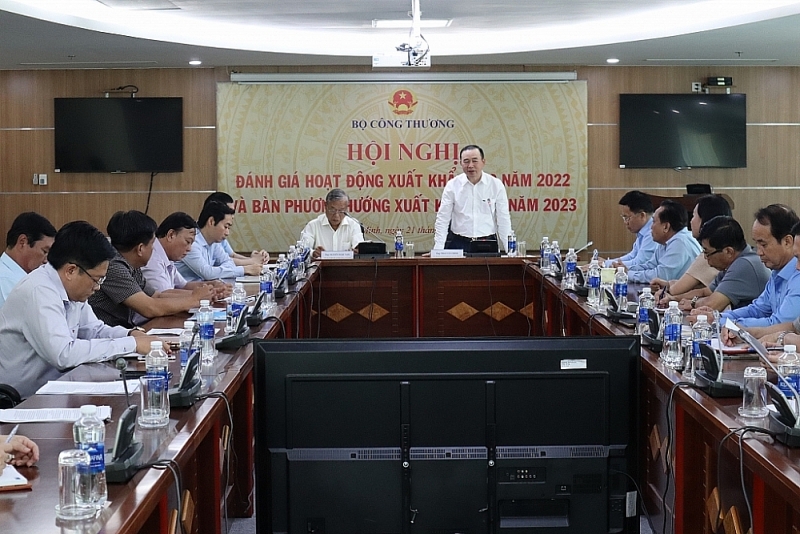 |
| Mr. Phan Van Chinh, Director of the Import-Export Department, made a speech at the conference. Photo: TL |
Attending the conference were representatives of functional units of the Ministry of Industry and Trade (MoIT) and the Ministry of Agriculture and Rural Development (MARD); leaders of Departments of Industry and Trade of provinces and cities in the Mekong Delta and HCM City; leaders of the Vietnam Food Association; and many big rice exporters.
According to the General Department of Customs statistics, as of mid-February 2023, Vietnam has exported 579,793 tons of rice worth US$304.8 million. However, compared to the same period in 2022, rice exports decreased by 10% in volume and nearly 3% in value.
At the conference, Tran Quoc Toan, Deputy Director of the Import-Export Department – MoIT, said that the average rice export price in January 2023 had reached US$519.3/ton, up 6.8% over the same period in 2022; this was a positive signal for rice exports in 2023.
Besides, Vietnam’s rice exports in January 2023 continued to dominate key markets with a great demand for output. However, the Philippines was still Vietnam’s largest rice import market, accounting for 35% of the country’s total rice exports (reaching more than 129,323 tons), down 44.7% over the same period in 2022 (because there were two long holidays – New Year and Lunar New Year in January 2023 ).
In the Chinese market, rice exports accounted for more than 13.2%, with an amount of 47,424 tons, up 13.2% over the same period in 2022. This growth was due to import and export customs clearance activities returning to normal at the northern border gates when China opened the northern border on January 8, 2023.
In January, it also recorded a growth rate of 100% in the Indonesian market, while in the same period in 2022, Indonesia did not have any import activities from Vietnam. Rice exports to Indonesia accounted for 24% of the country’s total exports, equivalent to 85,925 tons (mainly high-grade white rice and fragrant rice).
Some popular types of rice exported in January 2023: are fragrant rice (ST24, ST25, DT8, Ham Chau, and Nang Hoa), jasmine rice, japonica rice, and 5% white rice.
Accordingly, Vietnam’s rice export forecast in 2023 is about 6.5-7 million tons.
Tran Quoc Toan also highlighted some supporting factors for Vietnam’s rice exports in 2023. Specifically, climate change and drought in the US, the EU, and China are shortening the rice supply. Meanwhile, India banned exporting broken rice and applied a 20% tax on white rice to traditional markets such as Indonesia and Bangladesh. Especially the opening of China’s market after the Covid-19 pandemic has made import demand forecast the same as in previous years. Additionally, the quality of Vietnam’s rice exports is increasingly improved, and all countries have a demand to import from Vietnam.
In addition to the above-supporting factors, at the conference, the representatives of the Department of Industry and Trade of southern localities and businesses assessed that rice production, processing, and export activities in 2023 would face difficulties. Specifically, the cost of input materials increased while the export price has not increased correspondingly, causing difficulties in capital sources for traders. Besides, there is no connection to share information between traders to improve the quality and image of Vietnam’s rice brand, avoiding unfair competition affecting our rice reputation in some key markets.
There are also risks from geo-political fluctuations, high inflation, and natural disasters causing drought and crop failure in major rice-producing and exporting countries, affecting the world’s rice trade supply; the trend of countries to increase the application of trade and technical barriers to imported agricultural and aquatic products; and increased logistics costs.
In particular, businesses all raised their difficulties in terms of capital. They wished to be supported to access bank capital more conveniently to meet the demand for purchasing and storing rice at the peak of harvest.
Speaking at the conference, Phan Van Chinh, Director of the Import-Export Department, shared the difficulties of enterprises when the price of agricultural materials increased. However, this is the common price level of the world, and Vietnam has integrated into the world economy, so it will have to follow this trajectory. After the Russia-Ukraine war, the world agricultural materials market formed a new price level.
Regarding capital, the credit conditions of commercial banks with rice-exporting enterprises are very tight. Therefore, shortly, the MoIT will report and propose that the banking industry have an appropriate mechanism for rice businesses to ensure a balance between the safety of the bank and the supply of capital for businesses.
In terms of market, the MoIT will enhance trade promotion activities, strengthen the work of market information, and coordinate with diplomatic missions and trade representative offices abroad to continuously support enterprises to carry out rice export promotion activities.
